What to be on the lookout for…
Bacterial Diseases of Pumpkins
Pseudomonas syringae pv. lachrymans, more commonly known as angular leaf spot (ALS), regularly occurs each year in fields of cucumbers, melons, squash and pumpkins in CT. Lesions are irregularly shaped and bleach or turn gray as they age and expand, eventually breaking and leaving a “shot hole” through the leaf.
Xanthomonas cucurbitae, more commonly known as bacterial leaf spot (BLS) is less familiar in our region. With BLS, lesions begin very small (0.07 inches), but as they enlarge (0.07-0.15 inches), they can coalesce and look very similar to angular leaf spot. Therefore, it can be difficult to distinguish between them.
While the efficacy of copper materials is limited after the onset of the disease, it can help to reduce the spread. Tank-mixing or alternating between products such as ManKocide, Actigard, or Serenade may be more effective in reducing the spread than a single copper material.
Since both ALS and BLS are bacterial diseases, management is essentially the same. Both are seed borne, and can also be dispersed by rain, irrigation water, insects, machinery, and clothing. They also favor humidity and can survive winter on plant debris. Plow under crop residue after harvest and rotate away from cucurbits for 1-2 years when practical.
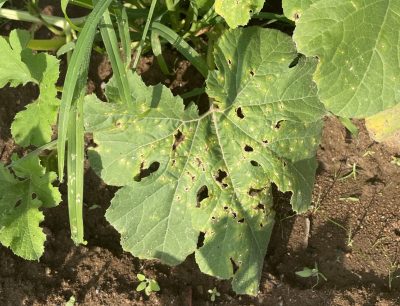
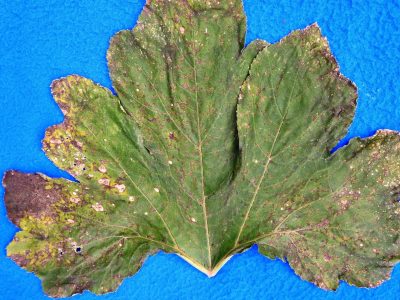
These pathogens can also impact fruit. For further information, visit the following resources:
- New England Vegetable Management Guide: Pumpkin, Squash & Gourds - Disease Control
- Angular Leaf Spot on Cucurbits (Cornell)
- Xanthomonas Leaf spot on Cucurbits (Cornell)
Alternaria and Black Rot in Crucifers
As the weather becomes more conducive to disease development, it’s likely we will see a rise in incidence and severity of Alternaria and black rot in crucifers. As the air temperature cools at night, the relative humidity rises, often reaching the dew point. Dew formation on plant surfaces fosters the development of fungal and bacterial diseases.
The most common symptom of Alternaria diseases is yellow, dark brown to black circular leaf spots with target-like concentric rings. Lesion centers may fall out. Individual spots coalesce into large necrotic areas and leaf drop can occur. Lesions can occur on petioles, stems, flowers, flower pedicels, and seed pods. Infections of broccoli and cauliflower heads can lead to complete deterioration of the heads and loose marketability.
Management best practices include:
- Avoid overhead irrigation if possible. When irrigation is needed, do it in the morning.
- Control weeds, especially those in the family Brassicaceae.
- Avoid working in fields when foliage is wet.
- Promptly incorporate plant debris after harvest, or mow if tillage is not possible in late fall crops.
As both diseases may be seed borne start with certified disease-free seed or plan to use a hot water treatment for future seasons. Practice a 3-year crop rotation with all brassica crops. Use proper plant spacing and row spacing for good air circulation.
Varieties differ in susceptibility to Alternaria. Blues F1 napa cabbage and Mighty Hybrid Brussels Sprouts have less susceptibility to ALS, but otherwise resistance is not very widespread. There are more options available for black rot resistant/tolerant brassica crop varieties including Report and Passat for late season cabbage and Belstar F1 broccoli. Use Cornell’s Disease Resistant Vegetable Crop Varieties as a resource when selecting seeds. The NEVMG also has related information in its Brassica crop section.
Fungicides are ineffective once the crop is infected with black rot. However, use of fungicides such as Howler and Regalia that induce plant resistance mechanisms preventatively can help. Double Nickel and Oso are examples of fungicides that can help control the spread of Alternaria.
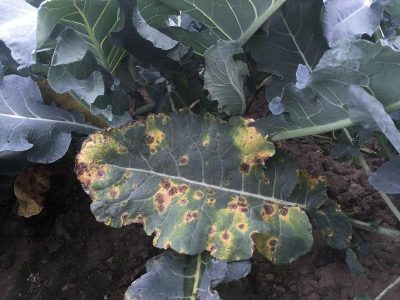
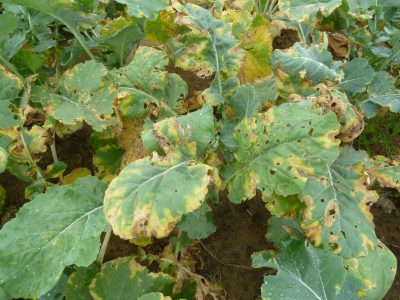
Winter Squash Maturity, Harvest, and Storage
There is a daunting list of diseases, insects, and weather events that threaten the quality of pumpkins and winter squash as we patiently await their maturity. Ideally the plants will stay healthy and the weather will cooperate all the way until the end, but that’s not always the case. Chuck Bornt, Vegetable Specialist at Cornell Cooperative Extension in Eastern New York, highlights what to keep in mind if you have winter squash and pumpkins in your field: Winter Squash and Pumpkin Maturity, Harvesting and Storage Tips.
Sweet Corn Pests - Trap Count Update
| Location | CEW (avg per night) | ECB - NY | ECB - IA | ECB - III | FAW |
| Glastonbury A | 0 | 1 | 0 | 0 | 2 |
| Glastonbury B | .43 | 0 | 1 | 0 | 7 |
View our Sweet Corn Pest ID Guide.
Spray intervals for CEW can be found on our website.
See the New England Vegetable Management Guide for management strategies for all sweet corn insect pests.
Participate in UMN/UNH High Tunnel Cover Crop Trial
Becky Sideman at University of New Hampshire is once again putting the call out to recruit organic high tunnel growers as part of an OREI funded high tunnel cover crops project. This Fall 2025 trial will look similar to last year’s: growers will get sent seed, a free soil test and help interpreting it, and will be asked to complete a couple of short surveys to let the researchers known how it went. A biomass sample from the following spring would be ideal as well, but is not required.
These on-farm trials are meant to evaluate how legume cover crops perform in active farming systems. Farmers will not be asked to plant replicated arrangements of the trial plots on their farms. Instead, researchers will plant all of the cover crop options in replicated plots on a research station, while each participating farmer plants one plot of each of the cover crop options that they select. Farmers can select between two levels of participation and compensation, depending on the amount of time and effort they are willing to commit.
- Read the full trial instructions, detailed species and timing menu, and farmer expectations for each level here.
- Watch the recording of the High Tunnel Cover Crop Trial Webinar
- Sign up to participate by telling the team which species you’d like to grow and how much seed to send.
Contact the research team at hightunnel-cc@umn.edu with any questions.
Continue to be on the lookout for the following pests...
Want the New England Vegetable Management Guide and/or Northeast Vegetable and Strawberry Pest ID Guide at your fingertips?
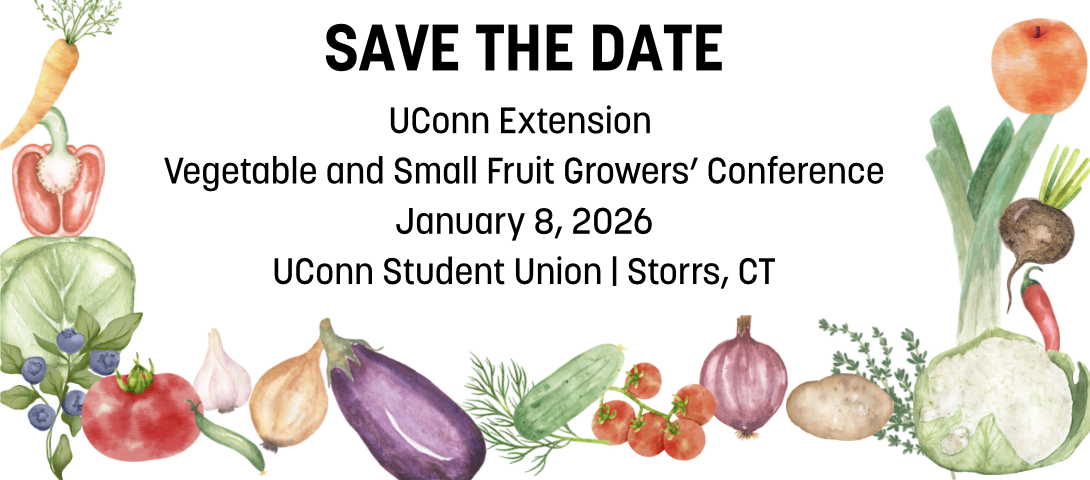
Stay in touch with us
- Share what you see: We're here to assist with identification, management strategies, and guidance on best practices. Send us a photo/message via iMessage at 959-929-1031.
- Facebook Group: UConn Extension moderates a private Facebook group specifically for commercial vegetable producers. It is a space to share photos of insects and diseases you find in your fields, ask questions, share ideas, and stay engaged with growers across the state. Join the "UConn Extension - Vegetable IPM" Facebook Group
- Schedule a consultation: Would you benefit from meeting with an Extension Specialist at your farm to provide insight on pest or disease identification, management strategies, and more? If so, please contact our Vegetable Extension Specialist, Shuresh Ghimire, to setup a farm visit. Contact him at shuresh.ghimire@uconn.edu or 860-870-6933.
Contact Information
Shuresh Ghimire, Vegetable Extension Specialist: shuresh.ghimire@uconn.edu
Nicole Davidow, Vegetable Extension Outreach Assistant: nicole.davidow@uconn.edu
Vegetable IPM Office Phone Number:
860-870-6933
Vegetable IPM Cell Phone Number:
959-929-1031 (feel free to text/iMessage photos)
Vegetable IPM Pest Alert Audio Recording:
860-870-6954
Thank you for reading!
This report was prepared by Nicole Davidow, Outreach Assistant, and Shuresh Ghimire, Commercial Vegetable Specialist, UConn Extension.

The information in this document is for educational purposes only. Any reference to commercial products, trade or brand names is for information only, and no endorsement or approval is intended. Always read the label before using any pesticide. The label is the legal document for product use. Disregard any information in this report if it is in conflict with the label. UConn Extension does not guarantee or warrant the standard of any product referenced or imply approval of the product to the exclusion of others which also may be available. The University of Connecticut, UConn Extension, College of Agriculture, Health and Natural Resources is an equal opportunity program provider.
